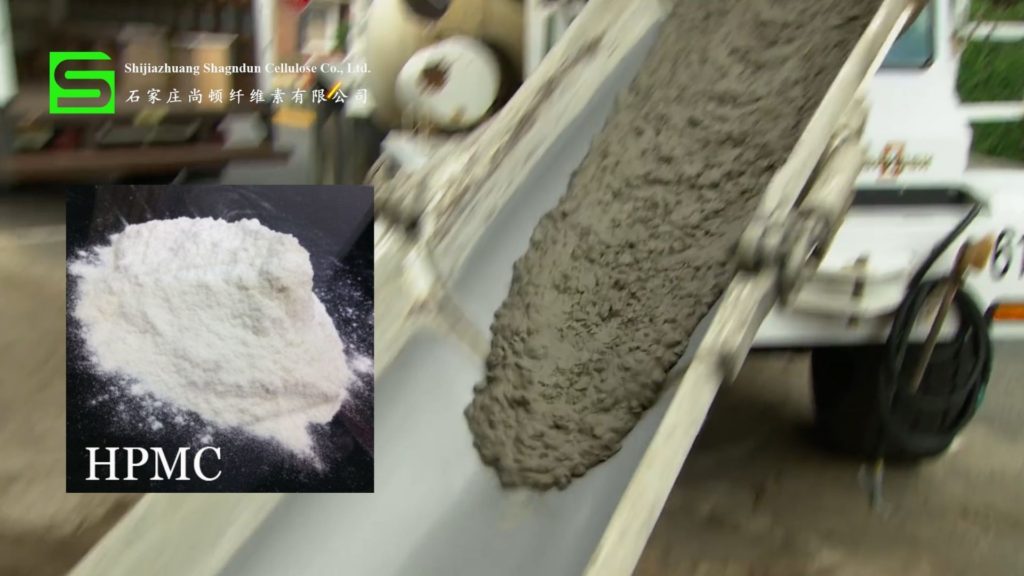Overview of Cellulose Ether
Cellulose ether is a kind of non-ionic semi-synthetic polymer, and has two kinds, water soluble and solvent soluble. Its effects caused in different industries are different. For example, in chemical building materials, it has the following combined effects: ①water-retaining agent, ② thickener, ③leveling property, ④film-forming property, ⑤binder; while in the PVC industry, it is an emulsifying agent and dispersing agent; in the pharmaceutical industry, it is a binder and sustained and controlled release matrix material, etc. It is because cellulose has a variety of combined effects that it is the most widely applied. The use highlights the use and role of cellulose ether in various building materials.
1. In Latex Paints
In the latex paint industry, select HEC of medium viscosity with the general specifications of HEC30000-50000cps, and it corresponds with HBR250 specification. The recommended dosage is generally about 1.5 ‰ -2 ‰. The major roles of HEC in latex paint is thickening, preventing gelation of pigment, and helping to disperse pigments and stabilize latex. And it can increase the viscosity of components and help to improve the leveling property of construction. HEC is more convenient to use, dissolved in both cold and hot water, not affected by the pH value, and easy to use at the pH value between 2 and 12. There are the following three using methods.

1.1 Adding Directly in the Production
In this method, HEC of delayed type and with the dissolution time over 30 minutes should be selected. The using steps are as follows: ①add the quantitative pure water into the container with high-shear blender; ②start to stir constantly at a low speed and at the same time, slowly add HEC into the solution evenly; ③continue stirring until all the granular materials are wet; ④ add other auxiliaries and alkaline additives, etc.; ⑤stir until all the HEC has been completely dissolved and then add the other components in the formulation, and grind up to the finished product.
1.2 Preparing the Mother Liquor Waiting to Use
In this method, HEC of instant type and with mildew proof effects can be selected. This method has the advantage of greater flexibility, so it can be added directly to the latex paint. The steps are similar to steps 1-4 in the first method.
1.3 Preparing Porridge-Like Substance Waiting to Use
Since organic solvents are poor solvents (insoluble) for HEC, these solvents can be used to prepare porridge-like substance. The most commonly used organic solvents are organic liquids in the paint formulation such as ethylene glycol, propylene glycol and film formers (such as diethylene glycol butyl acetate). The HEC in the porridge-like substance can be directly added into the paint. After addition, stirring should be continued until HEC has been dissolved completely and evenly.
2. Wall Scraping Putty

At present, the scrub-resistant, environmentally friendly putty has basically been valued by the people in most of the cities of China. In the previous several years, the formaldehyde gas emitted by the putty made of construction glue damage people’s health, and the construction glue is prepared by acetalization of polyvinyl alcohol and formaldehyde. Therefore, this material is gradually being phased out, the alternatives to this material are series of cellulose ether products. That is, for the development of environmentally friendly building materials, cellulose is the only kind of material.
The water-resistant putty is divided into two kinds: dry powder putty and putty paste. In the two kinds of putty, the modified methyl cellulose and hydroxypropyl methyl cellulose are generally chosen for use, and the viscosity is the most suitable between 30000-60000cps. In the putty, the main roles of cellulose are water retention, adhesion, lubrication and so on.
The putty formulations for each manufacturer are not the same. Some use ash calcium, light calcium, white cement, etc., while others use gypsum powder, ash calcium and light calcium , etc.. So the viscosity specifications and the addition amounts of the cellulose for the two formulations are also different. In general, about 4‰-5‰ and 100000mpa.s hydroxy propyl methyl cellulose is added.
In the construction of wall scraping of putty, since the the base surface of the wall has a certain water absorption (water absorption of 13% for the brick, 3-5% for the concrete), plus the evaporation of the outside, if there is excessive water loss of putty, it will lead to cracking or powder-off phenomena, thereby weakening the strength of the putty. For this, adding cellulose ethers will solve this problem. However, the quality of the filler, especially the quality of ash calcium, is extremely important. Since the cellulose has a higher viscosity, also enhances the adhesion of putty, avoids the sagging phenomenon in the construction and makes it more comfortable and effort-saving for wall scraping. In dry powder putty, it is appropriate to add more cellulose ether. Its production and use are both relatively convenient, just uniformly mixing the fillers and additives. Construction is also more convenient, with on-site water distribution, distributing depending on how much used.
3. Concrete Mortar

In concrete mortar, to achieve the ultimate strength, concrete must be fully hydrated. Especially in summer construction, concrete mortar is too fast in water loss and the measure taken for full hydration is maintenance watering. This method, on one hand, leads to waste of water resources and inconvenience of operation. The key is that water is just on the surface, while the internal hydration is still not complete, so the way to solve this problem is to add water-retaining agent cellulose into concrete mortar. Generally, choose hydroxypropyl methyl cellulose or methyl cellulose, with the viscosity specification between 20000 and 60000cps, and the addition amount of 2%–3% or so. The water retention can be increased to over 85%, and the using method is just adding water after uniformly mixing dry powder.
4. In Gypsum Plaster, Adhesive Plaster, and Caulking Plaster
With the rapid development of the construction industry, people have increasing demands for new building materials. Due to the increase in people’s awareness of environmental protection and the continuous improvement of construction efficiency, cementitious materials and gypsum products has made rapid development. Now the most common gypsum products are gypsum plaster, adhesive plaster, embedded gypsum and tile adhesives.
Gypsum plaster is a kind of good quality plastering material for interior walls and ceilings. With the use of it, the wiped wall surface is smooth and delicate, cannot afford to powder and is firmly bonded with the substrate, without cracking or shedding phenomena. And it has the function of fire prevention.
Adhesive plaster is a new adhesive for construction light boards, a sticky material with the
gypsum as the base material and made by adding a variety of additives. It applies to the bonding between all types of inorganic building wall materials. It is non-toxic, tasteless, and has early, strongly, and rapidly solidified as well as firmly bonding characteristics, so can be used as the supporting material in building panels and construction.
Gypsum sealant is the gap filler between gypsum boards and the repairing filler of walls and cracks. These gypsum products have a series of of different functions. The gypsum and related fillers work. In addition, the key issue is that the addition of the cellulose ether additive plays a dominant role. Because gypsum can be divided into anhydrite and hemihydrate gypsum, and different types of gypsum have different effects on properties of the products, so thickening, water retention and retarding properties determine the quality of gypsum building materials. The common problems in these materials are hollowing cracks and not reaching the initial strength. In order to solve this problem, the compound of the model of celluloses with the retarder can be chosen for use. In this regard, hydroxy propyl methyl cellulose 30000-60000cps is generally chosen, and the addition amount is 1.5% – 2%. In it, the cellulose plays a main role in water retention, retarding and lubrication.
However, in this process, the cellulose ether alone as the retarder cannot reach the effects, and the mixing use with the citric acid retarder will not affect the initial strength. The water retention generally refers to how much the natural wastage of water is in the absence of water absorption from outside world. If the wall is too dry, the absorption of base surface and the natural evaporation will make the material lose water too fast, and it will also appear hollowing, cracking phenomena. This using method is the mixed use of dry powder. If you want to formulate the solution, then you can refer to the preparation method of solution.
5. In Insulation Mortar
Insulation mortar is a new interior wall insulation material in northern regions, and it is a kind of wall material synthesized by insulation material, mortar and binder. In this material, cellulose plays a pivotal role of bonding and increasing the strength. Generally choose methyl cellulose of high viscosity (about 10000eps), with the dosage generally between 2 ‰ and 3 ‰, and the using method is mixing dry powder.
6. In Interfacial Agent
The interfacial agent is an adhesive, with superior adhesive force and excellent water resistance and resistance to aging. Improving the bond strength of plastering mortar can effectively avoid hollowing, shedding, shrinkage cracking and other issues on the plaster layer. It
can be used to process the surfaces of concrete, aerated concrete, sand-lime brick and fly ash brick, and to solve hollowing, cracking, and shedding problems resulting from the interface not easy for bonding since these surfaces are strongly absorbent or smooth.
It greatly enhance the adhesion between old and new concrete, and that between concrete and plastering mortar. It can replace the roughening process of traditional concrete surface, improve the plastering process of aerated concrete surface, and is an indispensable supporting material in modern architecture and decoration construction. Select HPMC20000cps for the interfacial agent, and over 60000cps for tile adhesives. HPMC mainly acts as a thickening agent in the interfacial agent and can improve the tensile strength and shear strength; while it acts as a water-retaining agent in tile adhesives to prevent tiles shedding resulting from too fast water loss.

